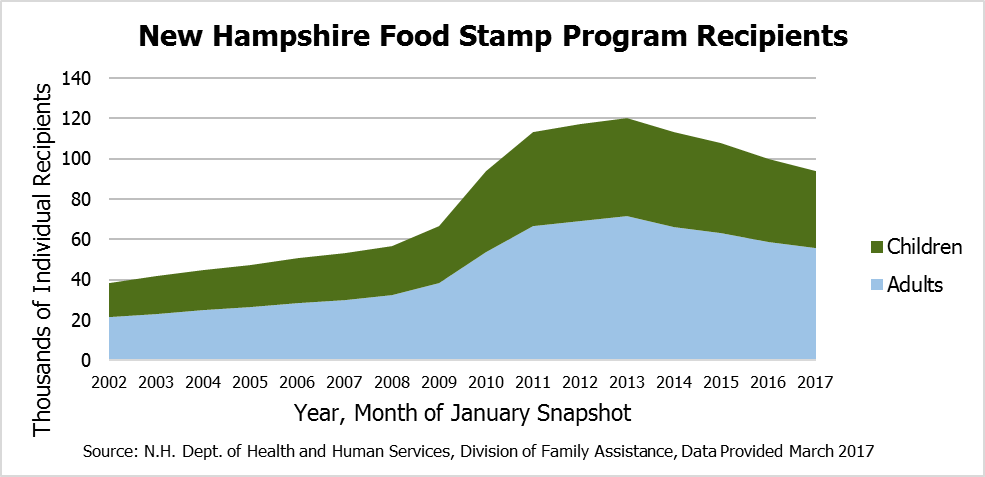The New Hampshire Food Stamp Program, also known by the federal designation Supplemental Nutrition Assistance Program (SNAP), provides resources to eligible individuals to purchase certain food items at grocery stores and other participating food retailers. SNAP benefits are designed to provide the difference between the cost of a nutritionally adequate food plan (designed by the U.S. Department of Agriculture) and 30 percent of the net household income, which is the portion expected to be used on food. The federal government funds 100 percent of SNAP benefits, and the cost of state-level administration is split evenly with the state government.
Eligibility
SNAP eligibility is determined based on income, expenses, resources, and number of members within a household. New Hampshire households may be eligible under a few key circumstances, primarily based on their gross income (which is income before allowable expenses), net income (gross income minus allowable expenses, including child care, housing rental, and utility costs within certain parameters), and assets (excluding certain assets, including a primary residence and vehicle). Not all members of a household may qualify; in certain circumstances, the number of qualified individuals receiving assistance may be smaller than the total household size. Generally, households qualify if:
- gross income is less than or equal to 130 percent of the federal poverty guidelines ($26,208 for a household of three in 2017), or 165 percent for elderly and disabled members;
- net income is less than or equal to 100 percent of the federal poverty guidelines ($20,160 for a household of three in 2017); and
- assets total no more than $2,250, or $3,250 for households with elderly or disabled members.
Households may also qualify under categorical eligibility. These households qualify if:
- all members qualify for receiving public assistance through Supplemental Security Income, Financial Assistance to Needy Families, Old Age Assistance, Aid to the Permanently and Totally Disabled, or Aid to the Needy Blind; or
- they meet New Hampshire’s expanded categorical eligibility criteria, meaning they earn gross income less than or equal to 185 percent of the federal poverty guidelines ($37,296 for a household of three in 2017) and have a dependent child with a relative in the household.
New Hampshire opted, amid the Great Recession in 2009, to expand categorical eligibility, which is a portion of the federal SNAP program that allows New Hampshire to bring in additional federal money to supply nutrition aid to more individuals. This expanded categorical eligibility allowed New Hampshire to provide federally-funded SNAP benefits beyond the federal 130 percent gross income standard and permitted benefit-eligible individuals to access benefits without the asset test. Expanded categorical eligibility only applies to households with children living with a parent or other specified relative, a restriction New Hampshire imposes that most other states with expanded categorical eligibility, which included 42 states in July 2014, have not.
Certain SNAP beneficiaries must work to obtain benefits. Individuals aged 18 to 50 years who have no dependents, are not pregnant, have not been medically-certified as physically or mentally unfit for employment, and do not reside in certain designated areas lacking available jobs, must work, be involved in a work activity, or be in a work training program for at least 20 hours per week to receive benefits for more than three months in a 36-month period. In New Hampshire, 14 towns and townships are designated as lacking available jobs.
Benefits
Benefits are provided based on a sliding scale calculated using a household’s size and net income. The benefit size is calculated by subtracting 30 percent of the household income from the maximum monthly benefit, which adjusts for size and provides a sliding scale benefit up to 100 percent of federal poverty guidelines. Those with net incomes above 100 percent of the federal poverty guidelines are not eligible for benefits. SNAP benefits are provided through Electronic Benefit Transfer cards, which act like debit cards and can only be used to purchase food items intended for human consumption and use. Specifically, benefits may not be traded or sold, and may not be used to purchase hot foods, vitamins, paper products, soap, alcohol, or tobacco.
The 2017 maximum benefit permitted for an eligible household of three, with no net income, is $511 per month, which is approximately $5.49 per person per day (with 31 days per month) or $1.83 per person per meal (with three meals per day). Monthly benefits decline as net income increases from zero. In January 2017, approximately seven percent of New Hampshire’s population received SNAP benefits, and 38,053 (40.5 percent) of the recipients were children.
Food Stamp and SNAP Resources
Sources used for this document and additional resources include:
- New Hampshire Department of Health and Human Services, Food Stamp Manual.
- The Center on Budget and Policy Priorities (CBPP), Policy Basics: Introduction to the Supplemental Nutrition Assistance Program (SNAP), March 24, 2016.
- CBPP, Chart Book: SNAP Helps Struggling Families Put Food on the Table, March 1, 2017.
- Congressional Research Service, The Supplemental Nutrition Assistance Program (SNAP): Categorical Eligibility, July 22, 2014.
- Mathematica Policy Research, Programs Conferring Categorical Eligibility for SNAP: State Policies and the Number and Characteristics of Households Affected, February 2014.
- Mathematica Policy Research, Non–Cash Categorical Eligibility For SNAP: State Policies and the Number and Characteristics of SNAP Households Categorically Eligible Through Those Policies, July 23, 2010.



